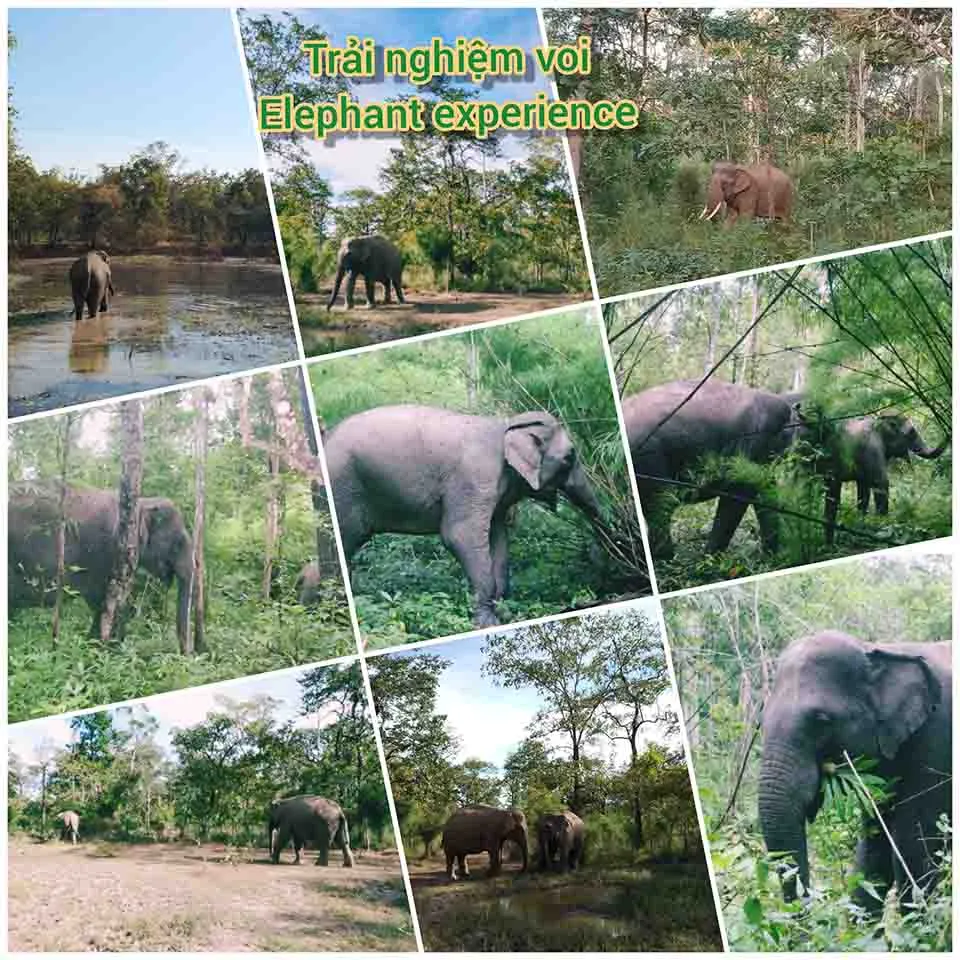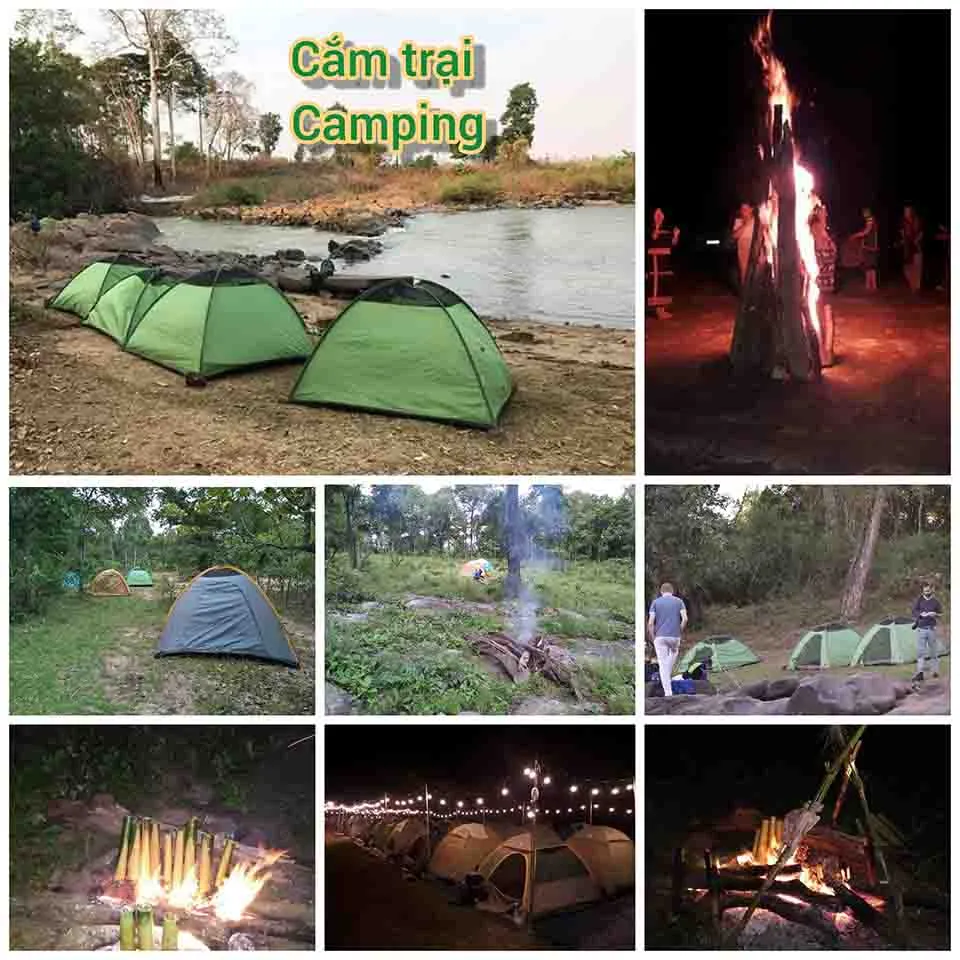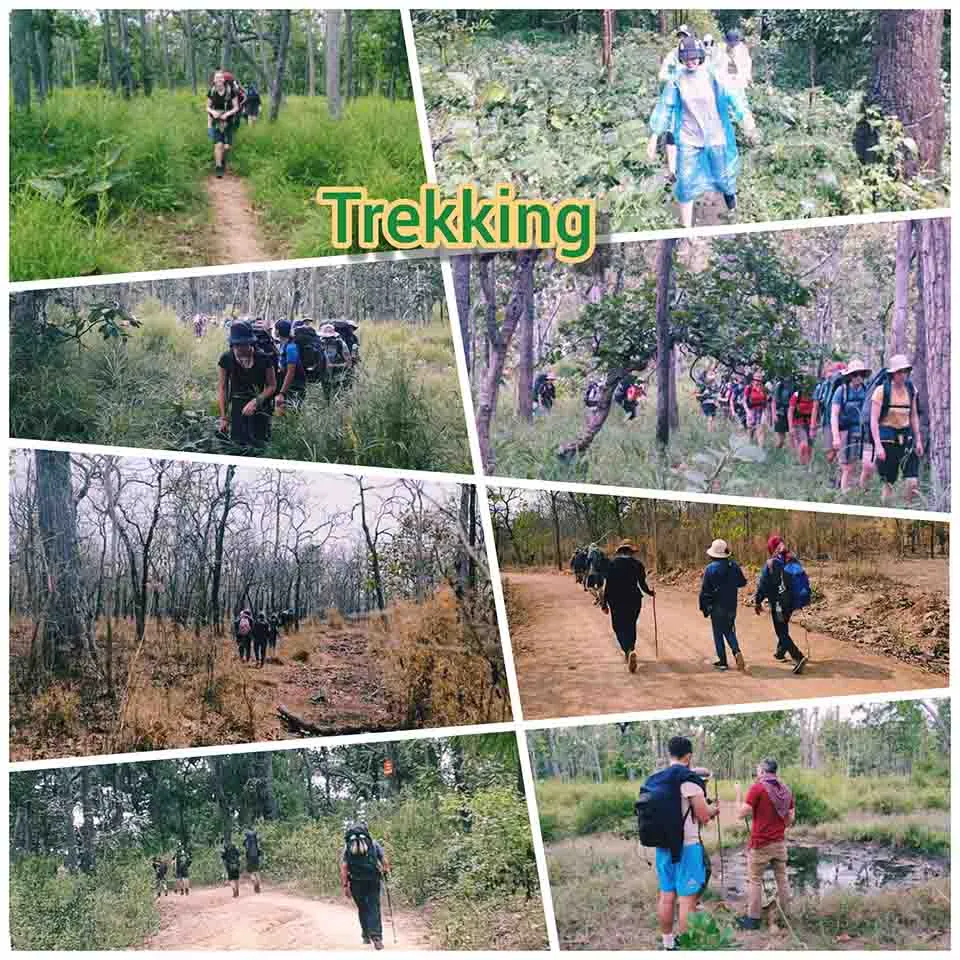Waking up in the heart of Yok Don National Park, you’ll immediately sense the difference. Birdsong echoes through the tranquil space, the fragrant scent of the forest permeates the early morning breeze, and the sunrise gently filters through the unique Khop forest canopy. Yok Don, the green gem of the Central Highlands, is not only the second-largest special-use forest in Vietnam but also a living museum of the unique Khop forest ecosystem, a convergence of biodiversity and distinctive indigenous culture, waiting for you to explore.
Overview of Yok Don National Park – A Green Gem in the Great Forest
Yok Don National Park, spanning a vast area of 115,545 hectares, proudly stands as one of Vietnam’s most significant nature reserves. Stretching across the administrative boundaries of 7 communes in 3 districts of Dak Lak and Dak Nong provinces, Yok Don is not only the “green lung” of the Central Highlands but also an appealing ecotourism and cultural destination for both domestic and international visitors.
The highlight of Yok Don is its Khop forest ecosystem, also known as deciduous dipterocarp forest, a unique and rare forest type not only in Vietnam but also worldwide. Yok Don’s biodiversity is showcased through impressive figures: 1,006 plant species and 650 animal species, including many rare species listed in the Vietnam and world Red Books, such as Asian elephants, gaurs, bantengs, various ungulates, and numerous precious wood species.
Beyond its ecological value, Yok Don also preserves and promotes the long-standing traditional cultural values of ethnic minority communities living in and around the buffer zone of the national park. This unique cultural intersection has transformed Yok Don into a distinctive cultural tourism center of the Central Highlands. Notably, Yok Don is also famous for its elephant-friendly tourism model, where visitors can experience the lives of both domestic and wild elephants in their natural habitat.
Location and Directions to Yok Don National Park
Yok Don National Park is strategically located, approximately 38km west of Buon Ma Thuot City, the center of Dak Lak province. Geographically positioned from 12°45’ to 13°10’ North latitude and from 107°29’30” to 107°48’30” East longitude, Yok Don lies in a tropical monsoon climate region, with two distinct seasons: the rainy season from May to November and the dry season from December to April.
To reach Yok Don National Park, visitors can travel by various means:
- By air: Buon Ma Thuot Airport (BMV) is the nearest airport. From the airport, you can easily hire a taxi or shuttle service to Yok Don.
- By road:
- From Buon Ma Thuot: Just 38km away, you can travel by motorbike, private car, or bus along National Highway 14C or provincial roads. The route is quite convenient and easy to navigate.
- From other provinces and cities: Bus routes from Ho Chi Minh City, Da Nang, Hanoi, and other central and southern provinces all have services to Buon Ma Thuot. From there, you can continue to Yok Don.
History of Formation and Development – From Special-Use Forest to National Park
Yok Don National Park was established in 1992 under Decision No. 301/TCLN dated June 24, 1992, by the Minister of Forestry, initially covering an area of 58,200 hectares. The establishment of the national park marked a significant turning point in forest and biodiversity conservation efforts in the Yok Don area, which plays a particularly important environmental and ecological role.
In 2002, recognizing the great importance and value of the forest, the Prime Minister issued Decision No. 39/2002/QD-TTg, expanding the area of Yok Don National Park to 115,545 hectares, affirming its position as one of the largest nature reserves in the country.
In 2013, according to Decision No. 2162/QD-TTg of the Prime Minister approving the “Overall Tourism Development Plan for the Central Highlands region to 2020, with a vision to 2030,” Yok Don National Park was designated as a national tourist area, with development orientations for sightseeing tourism, scientific research, exploration, adventure, ethnic cultural exploration, and relaxation.
Throughout its formation and development, Yok Don National Park has always focused on developing ecotourism in conjunction with conservation and promotion of indigenous cultural values, while creating sustainable livelihoods for local communities. The community-based ecotourism model at Yok Don not only provides unique experiences for visitors but also makes a significant contribution to the conservation and sustainable development of the national park.
Diverse and Rich Ecosystem – “Natural Museum” of Vietnam
Yok Don National Park is likened to a living “natural museum,” preserving the unique Khop forest ecosystem and boasting the highest biodiversity in Vietnam. Visiting Yok Don, tourists will be amazed by the pristine beauty of the primary forest, exploring the rich and diverse world of plants and animals.
Flora – The Unique Khop Forest Plant World
The flora of Yok Don National Park is incredibly rich and diverse, with over 1,006 plant species recorded, belonging to 132 families and 464 genera. The most distinctive feature is the presence of the Khop forest, a forest type that predominates and is characteristic of Yok Don. Khop forests shed their leaves in the dry season, creating a bare yet vibrant landscape, as new buds begin to sprout at the start of the rainy season.
In addition to Khop forests, Yok Don also features other forest types such as:
- Closed evergreen broadleaf forests: Growing along rivers and streams, with characteristic species like Hopea odorata, Hopea pierrei, and Dipterocarpus alatus.
- Closed semi-deciduous forests: A transitional forest type between Khop and evergreen forests, featuring Lagerstroemia calyculata, a easily recognizable tree with vibrant purple flowers in the summer.
Yok Don forest is also home to many rare and valuable plant species, of high economic and scientific value, such as precious woods (Sindora siamensis, Dalbergia bariensis, Pterocarpus macrocarpus, Dalbergia cochinchinensis), and medicinal plants (over 64 species). Yok Don’s rich vegetation not only creates beautiful landscapes but also plays an important role in maintaining ecological balance and providing a source of life for wild animals.
Fauna – Kingdom of Rare and Precious Wildlife
Yok Don National Park is a “kingdom” of wildlife, with 92 mammal species, 373 bird species, 55 reptile species, 18 amphibian species, 112 fish species, and over 437 insect species recorded. Among them are many rare and endangered animal species listed in the Vietnam and world Red Books, such as:
- Mammals: Asian elephants, gaurs, bantengs, wild water buffaloes, red muntjacs, Asiatic black bears, sun bears, leopards, tigers, dholes, black-shanked doucs…
- Birds: Peafowls, Siamese firebacks, great hornbills, rare waterbirds…
- Reptiles: Siamese crocodiles, box turtles…
Notably, Yok Don is one of the most important areas in Vietnam for Asian elephant conservation. The national park has been implementing numerous elephant conservation programs and projects, moving towards an elephant-friendly tourism model, contributing to raising public awareness about protecting this precious animal species.
Yok Don’s rich fauna is not only of scientific and conservation value but also a fascinating tourism resource. Visitors to Yok Don have the opportunity to observe wild animals in their natural habitat, participate in bird and wildlife watching tours, and experience exciting wild lives.
Cultural and Historical Values – Crossroads of Central Highlands Culture
Yok Don National Park is not only famous for its diverse ecosystem but also a place that preserves and conserves the distinctive cultural and historical values of the Central Highlands. The Yok Don region has long been a crossroads, a meeting point of many brotherly ethnic communities, creating a colorful cultural tapestry.
Visiting Yok Don, tourists have the opportunity to discover:
- Indigenous culture: Learn about the customs, traditions, traditional festivals, and unique stilt house architecture of the E De, M’nong, Lao, Tay, and Muong ethnic groups… Participate in community cultural activities, enjoy local culinary specialties, and engage in gongs, singing, and dancing performances.
- Historical relics: Explore revolutionary historical sites from the resistance wars against invaders, such as the Ho Chi Minh Trail and liaison wharves… These relics not only hold historical value but are also attractive destinations for tourists interested in learning about the nation’s heroic past.
Yok Don is also considered the “first capital” of Dak Lak province, marking important historical events in the formation and development of this land. This land is also associated with many legends and distinctive folk tales, reflecting the spiritual life and beliefs of indigenous ethnic communities.
Tourism in Yok Don National Park – Immersing Yourself in Wild Nature
Yok Don National Park is an attractive ecotourism destination, offering visitors experiences of immersing themselves in wild nature, exploring the diverse beauty of the Khop forest ecosystem, and learning about distinctive indigenous cultures.
Unique Types of Tourism in Yok Don
Yok Don offers various types of tourism, catering to the preferences and needs of many tourist demographics:
- Ecotourism: Long-distance walking (trekking, hiking) in the forest, wildlife watching, exploring the Khop forest ecosystem, camping in nature, and boating on the Serepok River.
- Cultural tourism: Visiting ethnic villages, learning about customs, traditions, traditional festivals, and enjoying gong culture and local culinary specialties.
- Adventure and sports tourism: Climbing Yok Don Mountain, mountain biking in the forest, kayaking, and whitewater rafting.
- Research and educational tourism: Participating in internships and research programs on flora, fauna, environment, indigenous culture, and environmental education activities.
- Elephant experience tourism: Participating in elephant-friendly tours, learning about the lives of domestic and wild elephants, experiencing river bathing with elephants, and feeding elephants.
Explore Attractive Destinations – From Waterfalls to Sacred Peaks
Yok Don boasts numerous attractive destinations, offering visitors unique nature and culture exploration experiences:
- Seven-Branch Waterfall (Thac Bay Nhanh): The most famous and unique tourist spot in Yok Don, where the legendary Serepok River splits into seven branches, creating majestic and poetic waterfall scenery.

- Buddha Waterfall (Thac Phat): A waterfall associated with a legend about monks, offering peaceful and tranquil beauty.
- Dak Lau, Dak Tol, Dak Ken Streams: Natural winding streams with crystal-clear water, ideal places to relax, fish, and immerse yourself in nature.
- Yok Don Mountain: The highest mountain in the national park, a symbol of Yok Don, covered with evergreen forest, offering the experience of conquering the peak and admiring panoramic views of Yok Don from above.
- Buon Don, Buon Jang Lanh, Drang Phok Villages: Traditional villages of ethnic minorities, where visitors can learn about the culture, architecture, customs, and daily life of local people.

Accommodation and Services – Amenities Amidst the Green Forest
Yok Don National Park provides basic accommodation and amenities to serve visitors:
- Yok Don Guesthouse: With 3 guesthouse areas and 19 airy, comfortable rooms with beautiful views of the river, lake, and forest.
- Tourist Camp: For visitors who love nature and want to immerse themselves in the pristine forest and mountain space. The camp is equipped with tents, hammocks, mattresses, pillows, and mosquito nets.
- Hammocks: Hammock rental service, suitable for visitors who want to rest and relax under the shade of forest trees.
In addition, Yok Don also has other services such as: a restaurant serving local cuisine, mountain bike rentals, dugout canoes, motorboats, and organization of gong cultural exchange activities, campfires, seminars, and events.

Yok Don Travel Tips – Ideal Time and Important Notes
To have a complete and meaningful Yok Don trip, visitors should note a few things:
- Ideal time to visit: The dry season (from December to April) is the most suitable time to visit Yok Don. The weather is dry, with little rain, favorable for sightseeing and exploration activities. However, if you want to experience the rainy season beauty of the Khop forest, the rainy season (from May to November) also offers its own unique charm.
- Preparation: Bring neat, comfortable clothing suitable for outdoor activities. Walking shoes, hats, sunscreen, insect repellent, and personal medications. If camping, you need to prepare tents, sleeping bags, and flashlights.
- Notes:
- Comply with the national park’s regulations on environmental protection, do not litter, do not make noise, do not hunt animals, and do not pick flowers or break branches.
- Respect the culture and customs of local people.
- Book rooms and services in advance, especially during peak tourist season.
- Carefully research information about tours and experience activities to choose the appropriate ones.
- It is advisable to travel in groups or hire local guides to ensure safety and have more useful information.

Conservation and Sustainable Development – Joining Hands to Protect “Our Common Home” Yok Don
Yok Don National Park is not only a tourist destination but also an important nature reserve, playing a significant role in protecting biodiversity and the ecological environment of the Central Highlands and Vietnam. Conservation and sustainable development are always prioritized at Yok Don.
The national park has been implementing many conservation activities and projects, such as:
- Khop forest ecosystem conservation: Researching, restoring, and developing Khop forests, protecting endemic plant and animal species of this ecosystem.
- Asian elephant conservation: Elephant conservation programs, building an elephant-friendly tourism model, and minimizing human-elephant conflict.
- Raising community awareness: пропаганда, educating local communities and tourists about forest protection and biodiversity conservation.
- Developing sustainable ecotourism: Developing tourism in conjunction with conservation, creating livelihoods for local communities, and minimizing negative impacts on the environment.
Responsible tourism in Yok Don not only brings economic benefits but also makes a significant contribution to conservation efforts. Every visitor to Yok Don can join hands to protect this “common home” by complying with regulations, respecting nature and indigenous culture, and supporting sustainable ecotourism activities.
Conclusion – Yok Don National Park – An Unmissable Destination in the Central Highlands
Yok Don National Park is a unique and attractive tourist destination in the Central Highlands, where visitors can explore the pristine beauty of the Khop forest, admire rich biodiversity, learn about distinctive indigenous cultures, and experience exciting ecotourism activities.
From the majestic Seven-Branch Waterfall and sacred Yok Don Mountain to traditional villages and unique elephant tourism experiences, Yok Don promises to bring visitors unforgettable memories and meaningful experiences. Come to Yok Don National Park to feel the wild natural beauty, discover unique cultural values, and join hands to protect the “green gem” of the great Central Highlands.